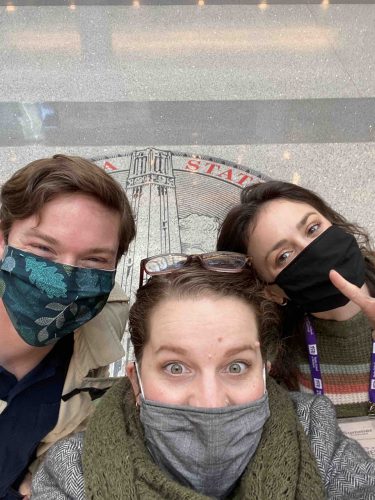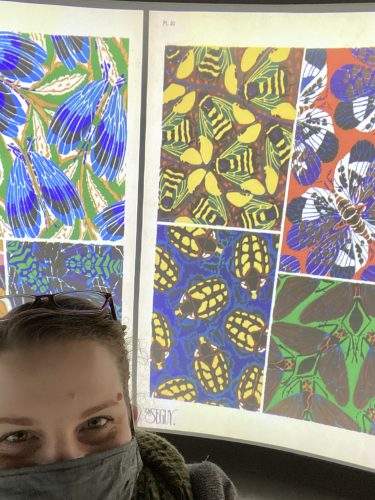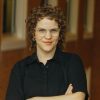Summer – Boardgames, Data, and more!
This January, Morgan and I went to NC State’s campus to attend the United States Association for Small Business & Entrepreneurship (USASBE) Conference. We both experienced NC State’s campus for the first time and were even able to meet up with our fellow BLINC member from NC State, in-person, for the first time ever! He even showed us around the library and provided us with an unforgettable experience in their data visualization lab. The conference itself was well attended, but hybrid. It of course had the expected technical challenges but overall the content was engaging!
My two favorite sessions at USASBE were about games invented to teach aspects of entrepreneurship. I am a huge board game and gamification fan so this instantly engaged and inspired me. Now I have a goal of making my own educational board game!
The first one was a physical board game out of Denmark that aimed to gamify understanding the various stakeholders in entrepreneurial ecosystems and to prompt dialogue between them to understand their varying motivations and perspectives. The best part for me was when the presenter, after being asked about the learning outcomes, said that one of the main learning outcomes is that the students “get an idea that they are not just students, they’re a part of something bigger than themselves and that in entrepreneurship you have to give something to gain something. They learn that the learning process is the center, not themselves.”
The second was a competitive team game created by a faculty member at Drexel University in Philadelphia. He calls this game/assignment ‘Disrupters v Defenders’. In this competition, he has students acting as both startup entrepreneurs (Disrupters) and corporate entrepreneurs (Defenders) and has them face off to learn the strengths, weaknesses, threats and opportunities of these roles. With this game, students spend 5 weeks in each of the roles. They switch half way through the semester so they get a feel for being both a defender and a disrupter. They’re given different scenarios and each week have to choose what they’ll do by choosing a character. There are various characters with varying strengths and weaknesses that will allow their team to react to the situation in different ways and give them points. To play the character, each team member has to complete a task. Each individual contribution drives the teams’ success. The complexity of this competition was impressive as well as the graphics.
Alongside my two favorite sessions was Morgan and I’s presentation, Data Driven Decision Making. We talked to a room of entrepreneurship faculty and entrepreneurship center directors about two instructional exercises we’ve come up with to teach students how to create ethical and effective survey questions for customer discovery and experience for themselves how making meaning from these surveys/data can be complicated. We do this by having the students make a survey and then give their survey to their peers. From there, they need to propose a decision from the results and share it with the survey takers to see if they made meaning in the way that aligns with their needs. The presentation seemed well received and we entertained multiple questions at the end.
Morgan- Mental health, more games, and improv, oh my!
Like Summer, I came out of USASBE excited by many of the activities and framing conversations that were shared.
Summer and I both attended a half-day pre-conference session exploring the mental health of entrepreneurs and how we can better prepare students to be more resilient in the face of very real anxieties and mental health concerns that are prevalent among entrepreneurs. The presenters highlighted that dealing with uncertainty and fear of failure are essential emotional skills for entrepreneurs but not often discussed or addressed in the classroom. As USASBE is primarily aimed at organizations such as universities, small business centers, and others whose focus is supporting the education and development of entrepreneurs, small business owners, and business students, the presenters wanted to emphasize the importance our organizations play in leading this charge toward more mental and emotional health awareness among these groups. For example, our organizations provide a safer space to practice the art of failing at something and learning from that experience than, say, in the “real world”. Additionally our organizations are fertile grounds to examine what role uncertainty can play in our lives, providing an opportunity to explore, examine, research, and discover, iterate, learn and try again – all skills many of us touch on in the library classroom. Overall, this session reminded me to think more deeply and holistically about how we frame exercises, materials, and discussions in the entrepreneurial classroom.
Two of my favorite conference sessions included active learning exercises – “The Magazine Game” and “Yes and…”. “ The Magazine Game” is market segmentation exercise encouraging students to engage with a variety of magazines (People, Vogue, Sports Illustrated, etc.) and focus on the advertising contained within and conduct research to create a customer profile (think demographic as well as psychographic) of the magazine’s intended audience and how that connects with the advertisers market. The presenter shared that she uses this in a hybrid class, having the in-class participants look at the ads in the physical magazines and the on-line participants research the magazine’s target audience. I love this exercise because (1) it encourages the use of physical materials in the business classroom and (2) it could be easily adaptable to a number of different formats including having students evaluate popular websites like BuzzFeed, New York Times, etc. It also provides students the opportunity to check assumptions against empirical data and research.
The “Yes and…” exercise explored using the improv technique of “yes and…” to encourage students to (1) think more creatively during the ideation process and (2) optimize the intelligence of a group. Students had to choose one of the UN’s sustainable development goals and develop a business idea that would address the goal. It’s common when generating business ideas that student’s will go with their first idea, never taking the opportunity to really dig into the ideation process (the “what-if” process if you will). This exercise breaks students into groups and requires them to go around sharing ideas on a solution and build on each other’s ideas by saying “yes and..” So, for example, if the goal we had was “zero hunger” someone may start off saying “we can start a food truck” and the second person would go “yes and, we will identify food desserts in our community and take the food truck there”, and the third person may go “yes and, we will work with local farmers to stock the food truck with fresh, free produce” and so on, and so on. Cycle after cycle of these “yes and…” sessions can be undertaken, allowing students to experience the freeing feeling of sharing ideas when the word “no” or “can’t” or “never” is not allowed.
In conclusion, one of the best things about USASBE is that it isn’t a Library conference. We have an unparalleled opportunity to build relationships with educators across the business and entrepreneurship discipline and show our value as librarians while also learning new approaches and emerging topics that allow us to bring opportunities for greater connection with faculty, students, and staff to Wake Forest and beyond.

(Morgan, Summer, & Shaun Bennett – NCSU’s Business Librarian – meet up at NCSU!)

(Morgan inside Hunt Library’s Data Visualization Studio)

9 Comments on ‘Morgan & Summer @ USASBE 2022’
Sounds like a great trip, and whoa the data viz lab does look unforgettable!
I LOVE that “yes, and…” exercise. Could be so useful in a variety of circumstances. Great write-up, y’all! Thanks!
That gamification sounds awesome! And so is the “Yes and I” exercise! Thanks for sharing!
Thanks, Morgan and Summer, for this excellent report! I’m excited to try some of these exercises in my classes! And I’m super envious that you got to see the dataviz lab–it looks amazing!
This is such a great post! Thanks for sharing about gaming, data visualization, NC State hospitality, and for giving us a peak into the exciting lives of business librarians.
Huzzah for in-person (even if still hybrid) conference experiences! Sounds like there were excellent sessions all around. Glad y’all were able to present, too!
That’s so great you got to go somewhere in person and attend an event that wasn’t just library-centered.
That conference sounds very informative *and* fun, which is a rare combo. Summer, we’ll have to talk board games sometime, my family and I are big game nerds. I find it interesting that there are a growing number of cooperative games, where the players play against the game, rather than each other. It seems like they could be used for a lot of instruction purposes.
So loved reading about this in-person meeting. Thanks for sharing!!